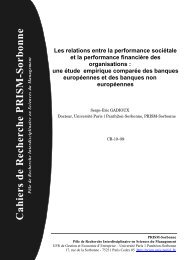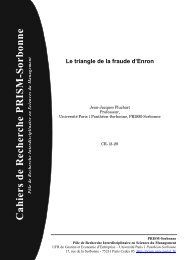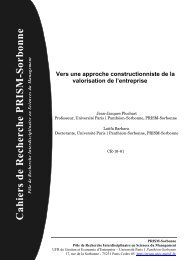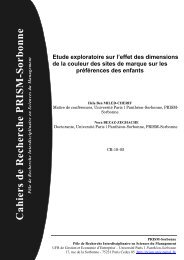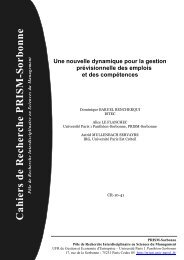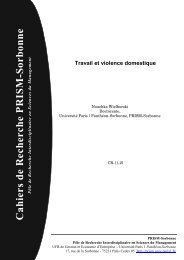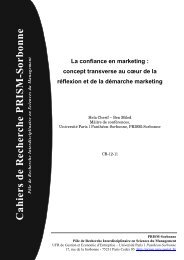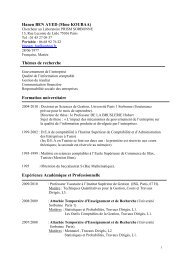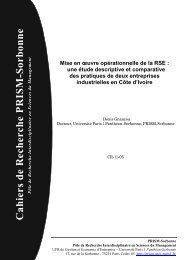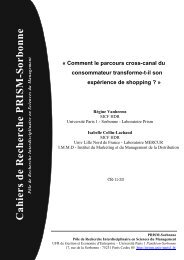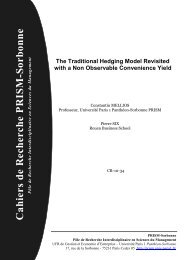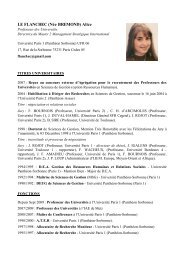Cahiers de Recherche PR ISM - Prism - Université Paris 1 Panthéon ...
Cahiers de Recherche PR ISM - Prism - Université Paris 1 Panthéon ...
Cahiers de Recherche PR ISM - Prism - Université Paris 1 Panthéon ...
You also want an ePaper? Increase the reach of your titles
YUMPU automatically turns print PDFs into web optimized ePapers that Google loves.
Title/Research QuestionPresenter NamesDateLab Session
R. Vanheems et F. Wehrle / <strong>Cahiers</strong> <strong>de</strong> <strong>Recherche</strong> <strong>PR</strong><strong>ISM</strong>-Sorbonne / CR 12-062 Literature Review2.1 Artificially created and natural coloursNatural colours differ from artificially created colours in their way of influencing humans. Wereact to colour co<strong>de</strong>s in stores and fashion or to specific anthropomorphic signs like trafficlights and to the colours of social organisations like political parties, the police and the firebriga<strong>de</strong>, because we have individually learned to associate all of these items with thecorresponding artificially created colours. It is important to stress, that human vision offerssuch a high colour resolution (Linhares et al., 2008), that we have the capacity not only toloosely associate any red with the fire briga<strong>de</strong>, but we can readily associate exactly the red ofour home town fire briga<strong>de</strong> with it. As such, reactions to artificially created colours are highlyinfluenced by our upbringing and cultural environment. Hence, it is a general belief that allreactions to colour vary individually. Still, colour psychologists have been trying to unraveluniversal reactions to various colours in humans for over a century, unfortunately, withoutconsistent results (Whitfield & Wiltshire, 1990). Consequently, the few recent studies on theeffect of colour in marketing based on colour psychological studies still encounter ambiguousor contradictory results (e.g. Cheng, Wu, & Yen, 2009, Lichtlé, 2007).In contrast, more parsimonious approaches from evolutionary and <strong>de</strong>velopmentalpsychologists, looking only at colour preferences, have shown in the last 20 years, that thereare universals to human reactions to colour: Humans appear to be born with a specific set ofcolour preferences, specifically preferring red over other colours (Adams, 1987; Franklin,Bevis, Ling, & Hurlbert, 2010). These innately attractive colours are most likely to haveoccurred in ancestral environments. Human and primate ancestors have evolved to react tothese colours because they gained benefits from these innate reactions over generations.However, these studies on basic colour preferences also acknowledge that, as humans growup, they may progressively adapt these preferences to contexts as they learn to appropriatelyassociate the artificially created colours in their society. In essence, our current un<strong>de</strong>rstandingof individual colour preferences is that there are un<strong>de</strong>rlying universal colour preferences,however, preferences might or might not be altered during individual <strong>de</strong>velopment <strong>de</strong>pendingon the social environment and the context.3
R. Vanheems et F. Wehrle / <strong>Cahiers</strong> <strong>de</strong> <strong>Recherche</strong> <strong>PR</strong><strong>ISM</strong>-Sorbonne / CR 12-06throughout cultures to attract mates (Knight, Power, & Watts, 2008).In contrast to the mating context, we see in primates that redness of skin in a competitioncontext effectively communicates the opponents arousal and willingness to fight (Bergman,Ho, & Beehner, 2009; Marty, Higham, Gadsby, & Ross, 2009; Setchell & Jean Wickings,2005). Also in this context, physiological studies in humans confirm that flushed skin iscorrelated with arousal (Drummond & Quah, 2001). Psychological studies and statisticalanalysis of sporting events have shown, that also in humans, individuals experience asubstantial <strong>de</strong>crease in physical and mental strength when confronted to red colouration in acompetitive context such as an exam or in a sporting combat (Elliot, Maier, Binser, Friedman,& Pekrun, 2009; Elliot, Maier, Moller, Friedman, & Meinhardt, 2007; Hill & Barton, 2005).In marketing, only few studies have actually tried to systematically approach consumerreactions to colour. For example, recent studies in France showed that the reaction to red inadvertisements <strong>de</strong>pends on the sex of the customer, the product type and the lightness of thered. As such, women prefer darker red over blue, whereas men do not differ between blue andred as long as they are both dark (M.-christine Lichtlé, 2005). Other studies show that theeffect of red is more inert to variation of personal preferences than the effect of blue (M.-christine Lichtlé, 2007). Furthermore, complex variables such as appeal and pleasure thatare linked to purchase <strong>de</strong>cisions are likely to not to be influenced directly by colour but viamo<strong>de</strong>rating variables such as individual optimal stimulation levels. When focusing onassociations of colour with brand personality, studies done in the United States showed thatmen and women found light red logos to appear most exiting, blue logos most competent, andpurple, pink and black logos most sophisticated (Labrecque & Milne, 2011).It is important to stress, that we are currently still in the early stages of empirical research oncolour in marketing. Hence, most studies have limited themselves to the four main hues (red,green, blue and yellow) and have focussed on the various effects that variation in saturation,lightness and contrast might produce, rather than which exact colour triggers a specificreaction. Consequently, with our growing knowledge on how colour parameters can have animpact on consumers and the ability to quantify colour in human perceptual colour space, wecan now begin to empirically assess which of the more than 2.3 million perceivable colours(Linhares et al., 2008) might best serve a given marketing purpose. However, as in thenatural contexts, in or<strong>de</strong>r to know which colours to test, we have to know why they mightactually trigger a reaction.6
R. Vanheems et F. Wehrle / <strong>Cahiers</strong> <strong>de</strong> <strong>Recherche</strong> <strong>PR</strong><strong>ISM</strong>-Sorbonne / CR 12-062.4 The evolutionary basis of reacting to redMammals are generally limited in their colour perception to blue and yellow hues, only someprimate species and humans share the ability to also distinguish between green and red hues(G. H. Jacobs, 2008). This ability arose due to a mutation in the colour receptor genes ofancestral primates some 35 million years ago. At that time, plants are thought to have alreadybeen exposing their ripe fruit to be eaten by birds which then dispersed the seeds (D Osorio &Vorobyev, 2008; Sumner & Mollon, 2000). The ability to perceive ripeness of fruit whichare a valuable food source also for primates, was a consi<strong>de</strong>rable advantage which still todayallows primates to effectively optimise their foraging (Lucas et al., 2003; Sumner & Mollon,2000). However, it was only an advantage to those individuals that were also attracted to thereddish colouration, contrasting against unripe fruit and the leaves in the background. Hence,combining the ability to perceive red colouration and the attraction to reddish colours issupposed to be the reason why both traits quickly spread throughout ancestral populations andwhy it is still preserved today (Allen 1879; Fernan<strong>de</strong>z & Morris, 2007).It is probable that the successive loss of pelage on strategic parts of the body like the face, thechest and the genitalia in primates and then on the whole body in humans, was driven by theresponse of individuals to the red<strong>de</strong>ning of unveiled skin (Fernan<strong>de</strong>z & Morris, 2007). Inaddition, in the mating context, positive attraction similar to the one in the food context, issupposed to be beneficial as skin redness is physiologically coupled with fertility, physicalfitness and health (Charkoudian et al., 1999; Stephen, Coetzee, et al., 2009). In thisperspective, the context of competition appears to be an exception where positive attractionwould be <strong>de</strong>trimental, and therefore, secondarily, there has been selection pressure on evasivebehaviour in this specific context.The alternative hypothesis as to why old world primates and ultimately humans lost some oftheir pelage and body hair, is that primates benefit from the fact that others can <strong>de</strong>tect health,physical fitness and even fertility via skin colouration (Changizi et al., 2006). Consequently,it has been proposed that today, specific selection for the ability to perceive fitness relevantcues via skin redness is the primary cause for human attraction to skin redness. However, asattraction to skin redness in the mating context has a high probability of not leading tooffspring because of the various things that can go wrong between mating and birth, the basic7
R. Vanheems et F. Wehrle / <strong>Cahiers</strong> <strong>de</strong> <strong>Recherche</strong> <strong>PR</strong><strong>ISM</strong>-Sorbonne / CR 12-06attraction to skin redness might still be caused by an attraction-bias to red.2.5 The sensory drive mo<strong>de</strong>lThe fact that the reaction to red is similar throughout different contexts might not appearespecially striking, especially not to marketers who witness this phenomenon on a regularbasis. However, it is puzzling to evolutionary biologists and psychologists alike: How canhumans react similarly in contexts with different selective pressures? Usua lly, if individualsshow a reaction it must ren<strong>de</strong>r benefits so it should necessarily be tied to one beneficialcontext. Furthermore, in some contexts, the reaction to a stimulus and the benefits from thereaction are so loosely connected that it is hardly possible to imagine any selective pressure tomaintain this reaction. For example, as already mentioned, between the moment of beingattracted to a certain amount of skin redness and the birth of offspring, there are aninnumerable amount of things that can go wrong, so that the selective pressure on beingattracted to reddish skin is expected to be very low.However, theoretically, similar stimuli may trigger the same reaction in various contextsbecause the uncertainties or losses in some contexts might be buffered by at least one verybeneficial context. This theory has already been outlined by Allen (1879) over one centuryago but only recent studies on various species during the last two <strong>de</strong>ca<strong>de</strong>s allowed scientists tobuild a comprehensive evolutionary mo<strong>de</strong>l to explain this phenomenon, the sensory divemo<strong>de</strong>l (Endler & Basolo, 1998). In fact, some species like guppies gained scientific famebecause researchers were able to manipulate females to be attracted to plain artificiallycoloured plastic discs that ren<strong>de</strong>r no benefits whatsoever (Rodd, Hughes, Grether, & Baril,2002). It turned out that guppies feed on orange fruit which are difficult to <strong>de</strong>tect and tocatch in rivers. Consequently, guppies appear to have evolved to be strongly attracted byorange colour stimuli. However, and fortunately for males, this attraction is not limited to thefood context: Females are attracted to everything that is orange, even the experimenters'coloured plastic discs. Males exploit this bias for orange to attract females for mating bydisplaying orange spots on their fins. Even if reacting to such <strong>de</strong>ceptive stimuli would be<strong>de</strong>trimental in the mating context, females apparently gain enough benefits from reacting toorange in the food context to be able to compensate for the <strong>de</strong>ception.8
R. Vanheems et F. Wehrle / <strong>Cahiers</strong> <strong>de</strong> <strong>Recherche</strong> <strong>PR</strong><strong>ISM</strong>-Sorbonne / CR 12-06What Allen (1879) proposed and Fernan<strong>de</strong>z and Morris (2007) have supported viaphylogenetic analysis is, that humans likewise exploit biases for specific natural colours in alltypes of coloured objects. As such, when humans need to attract attention, their mostsuccessful colour choices are red (e.g. fire briga<strong>de</strong>) and contrasting colourations of red againstgreen (e.g. traffic light). Furthermore, whereas the guppies' colour spots may be costly to themales and hence actually promote their fitness, such as skin redness in humans does, humansdo not display orange spots on their limbs nor do we display a lot of skin redness, humans an<strong>de</strong>specially women use reddish ornaments such as clothes, jewellery, rouge and lipstick, all ofwhich are truly <strong>de</strong>ceptive and unrelated to fitness, if anything, they can cover up pale skin ordivert attention from imperfections. Consequently, it seems plausible that such <strong>de</strong>ceptivestimuli may work because of a general bias in humans for the colour red.2.6 Peak shift phenomenonThe peak shift phenomenon offers the mechanistic explanation as to why humans react toexaggerated and potentially <strong>de</strong>ceptive red colouration, for example red ornaments and bodypaint. In psychology and behavioural ecology, researcher consistently find that the preferenceof a stimulus shows some variation, its optimum being referred to as the peak preference (tenCate & Rowe, 2007; Lynn, Cnaani, & Papaj, 2005). Many species show an innate or learnedpreference for a specific stimulus which lies on one end of a stimulus gradient, and at thesame time, they show an aversion to another stimulus on the opposed end of a gradient. Forexample, on the colour gradient from green to red in fruit, primates show aversion towardsgreen fruit and a preference for red fruit. The peak shift phenomenon manifests itself whenindividuals are presented with different stimuli along that gradient: The closer the originalstimuli fall together on the gradient, e.g. the more alike unripe and ripe fruit are, the moreindividuals will prefer stimuli that are even stronger than the attractive original stimulus. Forexample, knowing the natural colour difference between unripe and ripe fruit, individuals mayshow a preference for fruit that is even red<strong>de</strong>r than any kind of fruit they have ever seenbefore. This shift in peak preference has been intensively studied with learned stimuli onartificial gradients but it has also been shown to work with innate preferences along naturalgradients (reviewed in ten Cate & Rowe, 2007). Consequently, humans that show shiftedpreference towards exaggerated red ornaments and body paint may have been born or they9
R. Vanheems et F. Wehrle / <strong>Cahiers</strong> <strong>de</strong> <strong>Recherche</strong> <strong>PR</strong><strong>ISM</strong>-Sorbonne / CR 12-06may have learned to prefer a specific skin redness over pale greenish skin. However, they mayalso show shifted preference to these <strong>de</strong>ceptive stimuli because they generalize their peakshift behaviour from the food context, where red fruit is preferred over green fruit.2.7 Review conclusionOur literature review stressed the importance of natural colours in their ability to influenceconsumers' selective attention. Evolution has shaped human vision and behaviour such as tobe able to optimally perceive and react to important natural colours and contrasts such as redagainst green. The evolutionary sensory drive mo<strong>de</strong>l can give a theoretical explanation of thelong standing hypothesis that human reactions to red in various contexts are due to a generalappraisal of red throughout various contexts. Furthermore, the specific preference ofexaggerated red stimuli can be explained by a shift in peak preference along the green-to-redcolour gradient humans may have been born to or may have learned to associate with negativestimuli (green for unripe and unattractive) and positive stimuli (red for ripe and attractive).Based on these interdisciplinary findings we explored human reactions to redness in the foodcontext and in the mating context in a comprehensive experimental setting which will bepresented in <strong>de</strong>tail in the following.3. MethodIn our interdisciplinary literature review we have i<strong>de</strong>ntified red as a colour of specificimportance in three natural contexts: Foraging, mating and conflict. In two of these contexts,foraging and mating, humans show similar positive attraction to red. In two successiveexperiments we first empirically assessed if humans react to red in both natural contexts andsecond we tested if their preference for red colouration can be influenced by stimuli fromdistinct contexts. As we used novel interactive experiments and the human perceptual colourspace CIEL*a*b* (reviewed in Judd, 1966), which is still rarely used in marketing research,we will present our methods in <strong>de</strong>tail in this section.10
R. Vanheems et F. Wehrle / <strong>Cahiers</strong> <strong>de</strong> <strong>Recherche</strong> <strong>PR</strong><strong>ISM</strong>-Sorbonne / CR 12-063.1 Experimental settingWe conducted interactive optimisation experiments, in which participants could optimise theredness of a given image on an LCD screen. A total of 223 volunteers aged 18-30 years andwith full colour vision were recruited for the experiments at the university campuses of theUniversity of Göttingen, Germany, and the University of Freiburg, Germany.In a first experiment, we assessed if redness of fruit or the face of a potential mate wasassociated with a given quality. To this end, groups of participants optimised the redness of agreen apple for ripeness (13 men , 12 women) or a red apple for ripeness (13 men , 15women) and unripeness (12 men , 12 women). The prediction for this experiment was, thatparticipants would associate stronger redness with ripeness. Other groups optimised theredness of male or female faces for sexual attractiveness (26 men , 29 women) or sexualunattractiveness (24 men, 21 women). The prediction for this experiment was that participantswould associate stronger facial redness with sexual attractiveness.In a second experiment, we assessed if there was a common bias un<strong>de</strong>rlying the reaction tored in the food and in the mating context. To this end, we tested if the participants could beinfluenced in their skin colour preference of a potential mate by strong green or red colourstimuli that were emitted by objects from a non-mating context (here we used apples from thefood context). Participants were presented with either a green apple (13 men , 13 women) or ared apple (13 men , 13 women) for two minutes before optimising the redness of the facialskin of a potential partner. The first prediction for the second experiment was, that if the therewas pressure on humans to correctly assess fitness relevant cues via skin redness, they shouldnot be influenced by other colour stimuli and always prefer the same facial redness which isassociated with sexual attractiveness. In contrast, the alternative prediction for the experimentwas that if humans were not un<strong>de</strong>r pressure to perceive fitness relevant cues via skin rednessand their reaction to facial redness was influenced by an un<strong>de</strong>rlying bias, they wouldgeneralize their reactions to strong positive stimuli from the food to the mating context andconsequently show a peak shift in preference towards more red when primed with a redstimulus.11
R. Vanheems et F. Wehrle / <strong>Cahiers</strong> <strong>de</strong> <strong>Recherche</strong> <strong>PR</strong><strong>ISM</strong>-Sorbonne / CR 12-06colour assessment, as colour is mainly processed by the colour receptors in the fovea centralisof the humans eye, i.e. the region of the retina where the light coming from the fixated areas isfocussed on (Hansen & Gegenfurtner, 2009). Light from surrounding areas is mostlyprocessed as colourless light by peripheral parts of the retina. Consequently, in or<strong>de</strong>r to takeonly those colours into account that were <strong>de</strong>cisive for the participants colour optimisationprocess, we conducted eye-tracking experiments to <strong>de</strong>tect the fixations areas at the eyetrackinglaboratory of the Evolutionary Psychology - Emmy Noether Research Group,University of Göttingen.We showed the same food items or faces they had previously manipulated to the participantsand informed them, that they would see a change in colour balance similar to their ownmanipulation. We compensated for biases to the participants reactions that arise from the eyetrackingapparatus by limiting eye-tracking experiments to 30 seconds per picture.Furthermore, we only used the first 5 seconds to extract eye-tracking information to i<strong>de</strong>ntifythe regions of interest of each face and fruit for both sexes, respectively. In or<strong>de</strong>r to maximisethe fixation resolution we sampled eye movements at 250 Hz and recor<strong>de</strong>d fixations when theeyes fixated a point longer than 0,08 seconds.The output of the eye-tracker contained fixation points as well as horizontal and vertical<strong>de</strong>viances due to eye movement. The mean <strong>de</strong>viances over all participants were taken to<strong>de</strong>limit the mean fixation area (FA). The probability with which a given pixel of the picturehas been fixated by chance is the maximum number of fixations that could have beenrecor<strong>de</strong>d (MNF) during the first 5 seconds, divi<strong>de</strong>d by the number of fixation areas on a givenpicture (NFA).P= MNFNFAwithandMNF= 5s0,08 s =62,5NFA= NumberofpixelofagivenpictureFAUsing R (R 2.10.1, 2009 The R Foundation for Statistical Computing) we i<strong>de</strong>ntified all thepixels that were looked at more often than expected by chance (P) via Binomal Tests for eachface and fruit and both sexes, respectively.14
R. Vanheems et F. Wehrle / <strong>Cahiers</strong> <strong>de</strong> <strong>Recherche</strong> <strong>PR</strong><strong>ISM</strong>-Sorbonne / CR 12-06The colours of the pixels within these regions were extracted from all pictures. Using R (R2.10.1, 2009 The R Foundation for Statistical Computing) these colours were transposed intothe CIEL*a*b* colour space and analysed. In or<strong>de</strong>r to assure reproducibility we used the D65standard as ambient lighting spectrum for the transformation (ISO 10526:1999/CIE S005/E-1998).4 Findings4.1 Selective attention to specific areas of interestThe eye-tracking experiment showed the limited areas of our fruit pictures and our faces thatwere of interest to the participants when paying attention to change in redness. Whereas theareas where centrally located in fruit, the areas on the faces showed a T-shape along the eyesand the nose down to the lips (Fig. 1).Figure 1: Top: Original male and female face as presented to the participants for theinteractive optimisation experiment (censored for publication). Bottom: Areas of interest onthe male face as seen by women (left), and on the female face as seen by men (right). Only the15
R. Vanheems et F. Wehrle / <strong>Cahiers</strong> <strong>de</strong> <strong>Recherche</strong> <strong>PR</strong><strong>ISM</strong>-Sorbonne / CR 12-06suggests, that there might be a trend in women for being influenced by the red apple. Incontrast, men showed a clear preference for an amount of facial redness which was strongerthan the one associated with sexual attractiveness after having been subjected to a red apple(Exact Wilcoxon Rank Sum Test, preference n = 13, attractiveness n = 26, W = 88,5, p =0,015).5. DiscussionHuman reactions to colour are diverse to say the least. Our experiments are meant as a firststep to explore a novel evolutionary approach to un<strong>de</strong>rstand how consumers react to colour inmarketing contexts by i<strong>de</strong>ntifying and testing colours that trigger similar reactions in distinctnatural contexts. In natural communication systems, red appears to trigger similar reactions inthe food and in the mating context. We tested to what extent redness communicates quality inboth contexts and to what extent the preference of redness in the mating context isadditionally influenced by a bias for red in humans. In this section we discuss the results ofour experiments as well as novel methodological aspects.5.1 Selective attention to specific areasHumans are known to show strong selective attention <strong>de</strong>pending on psychological,physiological and environmental parameters (Chun et al., 2011). In experimental settings ithas been shown that the selective attention of the participants can be directed by theexperimenter (Balcetis & Dunning, 2006). By cueing our participants to the change inredness they would perceive during the eye-tracking experiment, we ma<strong>de</strong> sure to direct theirselective attention to the areas on the presented food items and faces that were <strong>de</strong>cisive for theassessment of redness. The eye tracker records these areas as the areas surrounding thefixation points. Our results confirm the importance of this method by showing that the areasof interest are not equally distributed over all the surface of the items or faces or even thescreen, on the contrary, the areas of interest show specific concentrations in the centre of thefruit items and along facial structures such as the eyes and the nose. These results are in linewith similar eye-tracking studies on the perception of human faces (Hsiao & Cottrell, 2008).As colour is processed mainly by the receptors in the fovea centralis (Hansen & Gegenfurtner,17
R. Vanheems et F. Wehrle / <strong>Cahiers</strong> <strong>de</strong> <strong>Recherche</strong> <strong>PR</strong><strong>ISM</strong>-Sorbonne / CR 12-062009), the measured colours around the fixations points were most likely the perceivedcolours.5.2 Redness stands for qualityHumans may associate colour with quality because they are born or because they have learnedto do so. Consumers are subjected to various colour co<strong>de</strong>s and artificial colourations and maylearn to associate red with the strength of a drug or a specific type of soda (reviewed byDivard & Urien, 2001). However, even natural colourations may be learned, for exampleapples from the Granny Smith strain never become red during the ripening process. Somehumans may have even learned to associate the lack of redness with the gustatorycharacteristics of those green apples and may prefer them over red apples. In our experiments,however, we show that redness is consistently associated with ripeness <strong>de</strong>spite variation inpersonal preferences and experience. This association is also ma<strong>de</strong> by related primate species(Lucas et al., 2003; Sumner & Mollon, 2000) and appears to be a common universal incatarrhine primates and humans. From primatological studies we know that natural fruit showa large variance in colouration and there is no one colouration that could be associated withoptimal ripeness or unripeness. Consequently, our participants also showed large variation inthe redness associated with ripeness. This means on the other hand, that a wi<strong>de</strong> range ofsimilar colours will trigger a reaction in humans or translated into a practical context: In or<strong>de</strong>rto trigger the wanted reaction, the food item must not only display one single colour but avariation of colours.Despite the intensive usage of human mo<strong>de</strong>ls for all kinds of marketing purposes, only somecompanies in the beauty industry, which are directly involved with facial attractiveness, haveinitiated specific scientific research on the influence of facial redness in humans (Fink,Grammer, & Matts, 2006; Fink & Grammer, 2001). However, recent studies mainlyconcerned with evolutionary aspects of human communication have shown that humans caninfer fitness relevant cues such as health and fertility via facial skin redness (Stephen,Coetzee, et al., 2009; Stephen, Law Smith, et al., 2009). Our results fall in line with thesestudies and show that humans also associate sexual attractiveness with a certain amount ofskin redness. Furthermore, we show for the first time that women are more precise in theirassessment of sexual attractiveness via skin redness than men. This result may suggest that18
R. Vanheems et F. Wehrle / <strong>Cahiers</strong> <strong>de</strong> <strong>Recherche</strong> <strong>PR</strong><strong>ISM</strong>-Sorbonne / CR 12-06women are un<strong>de</strong>r stronger pressure than men to correctly assess fitness via skin redness.5.3 Biased to react to redRed is known to be an influential colour which has been used since the dawn of human kindfor body painting and arts (Knight et al., 2008). Grant Allen (1879) suggested over a centuryago, that humans may be universally biased to be positively attracted to red colouration but ithas only been in recent years that strategic approaches in evolutionary biology andpsychology have provi<strong>de</strong>d empirical evi<strong>de</strong>nce of such a bias in humans (Elliot & Niesta,2008; Elliot et al., 2010). However, these few existing studies focus on the bias to react tored within a single context, for example men and women are more attracted to potential mateswearing red instead of another artificially coloured shirt. Consequently, the results of thesestudies do not allow us to assess if the observed preference peak shifts are based on learnedassociations of skin redness with quality (the shirt being unconsciously perceived as red skin),or if these reactions might be still influenced by an un<strong>de</strong>rlying bias for red.In our study we predicted that the participants either would or would not be influenced afterbeing primed with a strong green or red stimulus. Conform to the first prediction, womenwere not influenced by the priming with the green apple and showed only a trend of beinginfluenced by priming with the red apple. It appears plausible that women are un<strong>de</strong>r morepressure to correctly assess the fitness of a potential mate via skin redness, as for women,mating with a suboptimal mate is more costly than for men. However, conform to thealternative prediction, men were strongly influenced by priming with a red stimulus. It is notentirely clear why men should be less selected for assessing fitness via skin redness, asmentioned above, one plausible reason is the weak selective pressure on mating due to theloose connection to the actual birth of offspring. It remains the question why men would thenreact to red in the first place. As the red stimulus was presented on an object from a nonmatingcontext, we can conclu<strong>de</strong> that men, and to a lesser extent women, generalize theirreaction to red over distinct contexts, which, in turn, can be explained by a sex specificreceiver bias for the colour red.19
R. Vanheems et F. Wehrle / <strong>Cahiers</strong> <strong>de</strong> <strong>Recherche</strong> <strong>PR</strong><strong>ISM</strong>-Sorbonne / CR 12-066. LimitationsThe most obvious limitation in research on colour perception is visual impairment of theparticipants. When working with colour it is important to consi<strong>de</strong>r the fact that nearly 7 to10% of men show on of two forms of red-green blindness. These men are insensitive todifferences between red and green hues and are thus for example unable to differ betweenapple strains and are unable to see another person blush. In our experiments we selected forparticipants with full colour vision, consequently, our results do not apply to colour blindindividuals. Colour blindness is an important marketing aspect consi<strong>de</strong>ring that, on the onehand, up to 10% of the male consumers may be blind to the chosen colours and that, on theother hand, colours specifically chosen for colour blind consumers may attract the wholecolour blind segment.In our study we have been concerned with the association of quality with colour and colourpreference. However, we have not assessed the influence of these variables on the purchase<strong>de</strong>cisions in a specific marketing context. Marketing contexts show various parameters thatare likely to equally influence consumer behaviour and need to be consi<strong>de</strong>red. For example,recent marketing studies have correctly pointed out that consumers will always perceivecolours in the context of their own experiences (M.-christine Lichtlé, 2007). Consumershave learned to associate specific colours or colour co<strong>de</strong>s with products, ingredients, servicesetc. Leading brands play an important role in shaping these associations, such as theassociation of red with soda thanks to Coca Cola (L. Jacobs, Keown, Worthley, & Ghymn,1991). Consequently, when practitioners aim at attracting consumers by conspicuouscolours, they have to be conscious that for example natural colours and shapes mayuniversally attract a lot of attention, but they may be perceived as incongruous orinappropriate for the product, the service or the brand. It is still of utmost importance to assesshow appropriate consumers consi<strong>de</strong>r a given colouration in a given context, not only thegeneral attraction, and to test the influence on all variables that will eventually influence apurchase <strong>de</strong>cision.We sampled our participants randomly at two German university campuses, so our resultsshould be interpreted consi<strong>de</strong>ring this sampling method. We tried to minimize the influence ofcultural implications or personal preferences, for example by asking the participants tooptimise an apple not according to their personal preference but so as to appear optimally20
R. Vanheems et F. Wehrle / <strong>Cahiers</strong> <strong>de</strong> <strong>Recherche</strong> <strong>PR</strong><strong>ISM</strong>-Sorbonne / CR 12-06ripe. However, it is conceivable that some cultural or personal traits may impair theobjectivity of the participants' judgements and we need to be conscious that <strong>de</strong>spite randomsampling, given the sample size of each group, single individuals may still have had an impacton our results.7 Further research7.1 Theoretical implications for future colour researchThe omnipresence of colour in marketing emphasises its managerial importance. Colourationplays a central role in as little as a one time print advertisement up to as much as in being acentral part of brand content and being used throughout a company for stores, sales uniforms,logos, signs, websites, packaging, product <strong>de</strong>sign and advertisement. However, thecomplexity of human reactions to colour makes the choice of a<strong>de</strong>quate colour a difficult task:Marketers have to make their choice amongst over 2.3 million perceivable colours (Linhareset al., 2008) each of which may trigger different reactions of varying intensity <strong>de</strong>pending onthe individual psyche and physiology of a consumer, selective attention, context, culture,environment etc. Furthermore, marketers have to account for conflicting parameters such asambient lighting, selective attention, cultural biases etc. It is our belief that it is only throughdirected empirical marketing research that researchers will be able to <strong>de</strong>liver sound data andstraightforward methods for practitioners to enable them to successfully work with colour.Colour psychological data has already proven to lead to ambiguous results <strong>de</strong>spite precisecolour measurement (reviewed by Divard & Urien, 2001). Based on our study we suggestthat sensible choice of colour should start with consi<strong>de</strong>ring how humans react to colour innatural communication systems. According to the sensory drive mo<strong>de</strong>l, if specific colourstimuli are observed in different natural communication systems, there is a good chance thathumans generalize their reactions to these stimuli throughout different natural contexts andthat these reaction will also be triggered by similar stimuli in a marketing contexts. Futureresearch will thus have to test natural stimuli in specific marketing contexts, such as productand web <strong>de</strong>sign, packaging, advertising etc.21
R. Vanheems et F. Wehrle / <strong>Cahiers</strong> <strong>de</strong> <strong>Recherche</strong> <strong>PR</strong><strong>ISM</strong>-Sorbonne / CR 12-067.2 Methodological implications for future researchColour research in marketing has adapted means of standardizing colour measurement thatincrease reproducibility. The CIEL*a*b* colour space is easily accessible for researchers andpractitioners, as professional colour manipulation software such as Adobe Photoshop allowscolour manipulation in the CIEL*a*b* dimensions and many data analysis programs such asR offer pre-constructed algorithms which allow the transformation of RGB values intoCIEL*a*b* coordinates (Ihaka et al. 2011). Furthermore, open source software such asColourSpace (http://www.couleur.org) allow researchers and practitioners to easily visualisecolours in CIEL*a*b* with different ambient lightings.Working in the CIEL*a*b* colour space allows researchers to quantify colour as well ascolour contrast. Future research can focus on assessing which colours are emitted by givenobjects and what the exact differences are between the colours of given objects. However,printed colours or colours presented on computers screens are limited and unevenlydistributed in the human perceptual colour space which itself shows various distortions. Forexample humans are much less sensitive to saturation differences in blue hues and,additionally, computer screens tend to have a very limited resolution of blue hues.Consequently, visualising colour in CIEL*a*b* or similar colour spaces, is a crucial step forfuture research. With respect to saturation, visualising colour in CIEL*a*b* allows to accountfor the fact that merely increasing saturation may cause only very little perceptual changes,for instance in blue hues, or may lead to tremendous perceptual changes, for instance in redhues. Similarly, blue hues can maintain high saturation much longer while becoming lighter,whereas red hues loose saturation when becoming lighter.For our experiments we chose a novel interactive optimisation method in which participantscould manipulate colour of given objects until they perceived them as optimal according to agiven quality. This type of experiment is very brief and easy to do for participants.Furthermore, it ren<strong>de</strong>rs more accurate results as forced choice experiments because thepresented objects are not biased by the experimenter and the active manipulation processallows participants to change the objects until they are satisfied.Using standardised ambient lighting when taking the pictures, when presenting the objects oncalibrated screens and when transforming RGB data into CIEL*a*b*, researchers andpractitioners can make sure that the colours in the analysis are the ones that have been22
R. Vanheems et F. Wehrle / <strong>Cahiers</strong> <strong>de</strong> <strong>Recherche</strong> <strong>PR</strong><strong>ISM</strong>-Sorbonne / CR 12-06perceived and that their results can be reproduced. Most importantly, the use of a commonambient lighting standard (e.g. D65) throughout visual research disciplines, future researcherswill be able to reproduce existing results, combine their data and compare their findings.Our eye-tracking experiment has shown, that humans selective attention leads to the visualfixation of only a limited number of areas on a given object. When working with colour, it isimportant for researchers and practitioners to assess which areas of an object are of interest toconsumers and will be fixated because colours are mainly perceived by the receptors on thefovea centralis (Hansen & Gegenfurtner, 2009) and peripheral colours may be ignored. Futureresearch will have to account for this restriction, however, researcher may also refer toexisting eye-tracking studies from other disciplines to learn which areas of an object might befixated, such as the eyes and the nose rather than the cheeks on human faces.In or<strong>de</strong>r to assess if the reaction to red was positively biased in the food and in the matingcontext, we conducted simple priming experiments where participants were primed withstrong stimuli from another context before an optimisation experiment. Future research canreadily use priming when participants are predicted to react with a peak shift in preference. Ifa peak shift is observed even when primed with objects from distinct contexts, there issubstantial evi<strong>de</strong>nce that humans generalize their reaction to the stimulus throughout distinctcontexts. Once a context in<strong>de</strong>pen<strong>de</strong>nt stimulus is i<strong>de</strong>ntified and tested, researchers can test theinfluence of the stimulus in marketing context using the prediction that consumers will reactaccording to the reactions observed in the natural context.8 Managerial implications8.1 Two approaches for working with colourMarketers may have to work with colours throughout all aspects of the mix, the primary goalof colour as a marketing tool being to trigger a reaction in a consumer. In practice, there aretwo basic situations in which the practitioner has to <strong>de</strong>al with colour: First, when a novelcolour has to be chosen in or<strong>de</strong>r to influence consumers, and second, when the colour hasalready been chosen and the context needs to be adapted so as to influence consumers. Ourstudy suggests two distinct approaches to these situations:1) If a novel colour has to be chosen for a product, a packaging, a website, a store, anadvertisement, a sales uniform, a brand logo etc., practitioners may first assess which23
R. Vanheems et F. Wehrle / <strong>Cahiers</strong> <strong>de</strong> <strong>Recherche</strong> <strong>PR</strong><strong>ISM</strong>-Sorbonne / CR 12-06reaction should be triggered in consumers via the colour stimulus. Second,practitioners may research which colours trigger the wanted reaction in naturalcommunication systems. Third, they may experimentally assess if the reactions to thenatural colours are similar in distinct contexts. Finally, practitioners can readily testthe prediction, that the consumers' reactions to the colour will be similar in the naturaland the marketing context.2) If a colour has already been chosen, practitioners may first assess which reactionshould be triggered in consumers via the colour stimulus. Second, practitioners mayresearch in which natural communication systems the given colour triggers the wantedreaction. Third, practitioners may experimentally assess if the reactions to the naturalcolours are similar in all known contexts or if they are only similar in a certain type ofcontext. Finally, practitioners can readily test the prediction, that the consumers'reactions to colour in a natural context will be similar to a marketing context, whichhas been adapted to resemble the natural contexts triggering the reaction.8.2 Adapting to the global marketThe global marketplace poses tremendous challenges for practitioners trying to marketproducts and services throughout most diverse cultures. Colour has proven to be a sensitivesubject as cultural biases may lead to a great <strong>de</strong>mand in one society and to categoricalrejection in another (reviewed in Divard & Urien, 2001). Practitioners facing either thechoice of a new colour or the necessity to work with an existing colour, must make a strategic<strong>de</strong>cision on how to approach the colour issue. We have presented two practical approaches forthe work with novel or existing colours. In both approaches, practitioners need to i<strong>de</strong>ntifynatural communication systems in which humans show the reactions that should be triggeredin consumers. Because these reactions have evolved in human and primate ancestors, they arelikely to be universal in mo<strong>de</strong>rn humans. Consequently, when facing global markets,practitioners can start with the straightforward prediction that humans will react to the colourstimuli according to the reactions observed in natural contexts.In general, consumers around the world should comply to this prediction, however, some willmost certainly not. On the basis of the predicted reactions, practitioners can hence readilymeasure <strong>de</strong>viances and use them to i<strong>de</strong>ntify cultural biases which in turn allow for thorough24
R. Vanheems et F. Wehrle / <strong>Cahiers</strong> <strong>de</strong> <strong>Recherche</strong> <strong>PR</strong><strong>ISM</strong>-Sorbonne / CR 12-06segmentation. In essence, instead of an erratic trial and error approach based on inconsistentcolour psychological data or subjective suggestions from in<strong>de</strong>pen<strong>de</strong>nt organisations such asthe Color Marketing Group, our study suggests a well directed strategic approach with clearpredictions based on universal human reactions to colour stimuli in natural communicationsystems.8.3 Specific implications for the choice of colour for products and packagingColour choice is important throughout the mix, however it is of central interest for product<strong>de</strong>sign and packaging. Here, practitioners face the dilemma of being required to conform togiven colour co<strong>de</strong>s while being required to create conspicuous colourations in or<strong>de</strong>r to attractthe consumers' attention. Hence, it is crucial for practitioners to consi<strong>de</strong>r the category of theproduct before choosing colour, as the category <strong>de</strong>ci<strong>de</strong>s in which store the product will besold, in which section of the store it will be presented and which colour co<strong>de</strong> competingproducts and packagings will display. The consumers' selective attention will be directed tothe colour co<strong>de</strong> of the product type allowing them to easily find the correct shelves in a store.There, colours in line with the colour co<strong>de</strong> may ren<strong>de</strong>r the product or packaging cryptic. Onthe other hand, extreme nonconformist colouration of the product and packaging may beunintentionally ignored by consumers who are focussed on the colour co<strong>de</strong>. From our studywe can extrapolate two strategies that may allow practitioners to attract more attention <strong>de</strong>spiteselective attention to an existing colour co<strong>de</strong>.First, colouration can exploit the peak shift phenomenon if there are differences in colouringwithin the colour co<strong>de</strong>, which consumers have learned to associate with different qualities.For example, if weak drugs show light blue and strong drugs show light red colouration, thencustomers searching for strong drugs are likely to show a peak shift and prefer a packagingwith a stronger red. Inversely, if <strong>de</strong>tergents that contain a lot of ingredients that wash verywell but might harm the environment generally show a lot of saturated colours whereas<strong>de</strong>tergents that are less harmful to the environment show a little less colourful packaging,customers searching for environmentally friendly <strong>de</strong>tergents might show a peak shift towardsvery subtle and even more poorly saturated colouration.Second, natural colours, if possible combined with natural shapes, may also attract attentionto colours inconsistent with the colour co<strong>de</strong> just because humans have evolved to react to25
R. Vanheems et F. Wehrle / <strong>Cahiers</strong> <strong>de</strong> <strong>Recherche</strong> <strong>PR</strong><strong>ISM</strong>-Sorbonne / CR 12-06these colours. For example, we can again extrapolate from our study that packagings showingfruit sized reddish shapes will automatically attract attention. This effect can be even strongerif the colour co<strong>de</strong> shows the same gradient as the natural stimuli such as to allow the naturalcolours to use a peak shift in preference. For example, if red labels are shown on milk bottleswith non-organic milk and green labels are shown on bottles with organic milk, consumersmight generally be more attracted to the bottles showing reddish roun<strong>de</strong>d shapes with asaturated red, however, consumers searching for non-organic milk are likely to additionallyshow a peak shift and prefer even stronger reddish colouration.8.4 Specific implications for the choice of colour for brandsThe colour scheme of a brand bears specific importance as it is a central part of brand i<strong>de</strong>ntityand personality. The brand's colour is used almost everywhere, from service uniforms tologos, from packing to the band name itself, as nicely illustrated by the French Orange andthe German Blau.<strong>de</strong>. Colour is a central aspect of how consumers perceive the brand(Labrecque & Milne 2011). How well the virtues of a brand are perceived is a result of howwell the brand colour matches the colour which consumers associate with the qualities theyare looking for. Practitioners thus have to optimise the colour scheme of a brand so as to fit toconsumers' expectations.From our study, we can distinguish at least three different factors, that shape consumers'perception of quality via colour. First, famous brands dictate the colour scheme of a specifictype of company, which consumers have learned to associate with the quality of this leadingbrand. For instance, red in soda drinks is associated with the quality <strong>de</strong>livered by CocaCola(reviewed in Labrecque & Milne 2011). Consequently, practitioners have to adapt their brandcolour to the leading brand's colour in or<strong>de</strong>r to avoid inattentional blindness or negativeassociations.Second, consumers may show a general bias to react to specific colours which they have beenborn to or which they have learned to associate with specific qualities in a given context. Forexample, if consumers generalize their association of the redness with ripeness in fruit (i.e.high nutritive value and sugar content), brands producing sweets such as Kin<strong>de</strong>r may profitfrom consumers that generalize this association to various types of food. If consumers arefound to generalize their quality associations, practitioners can exploit these reactions by26
R. Vanheems et F. Wehrle / <strong>Cahiers</strong> <strong>de</strong> <strong>Recherche</strong> <strong>PR</strong><strong>ISM</strong>-Sorbonne / CR 12-06offering brand colours according to the consumers learned or innate associations of qualitywith colour.Third, quality can be correlated with colour along a consistent colour gradient. In this casethere is an optimal quality, that is associated with a specific colour. Brands showing a colourwith a stronger or weaker saturation or lightness, as compared to the colour of optimal quality,may be associated with an even better quality. For example, if darker brown is associated witha higher amount of cacao in chocolate, a brand with an extremely dark brand logo may beassociated with having even more cacao. Practitioners may use this peak shift in association tooptimise the association of quality with their brand whilst staying within the given colourscheme or colour co<strong>de</strong>.27
R. Vanheems et F. Wehrle / <strong>Cahiers</strong> <strong>de</strong> <strong>Recherche</strong> <strong>PR</strong><strong>ISM</strong>-Sorbonne / CR 12-06ReferencesAdams, R. (1987). An evaluation of color preference in early infanc y. Infant Behavior andDevelopment, 10(2), 143-150.Allen, G.(1879). The colour-sense: Its origin and <strong>de</strong>velopment. Boston: Houghton, Osgood &Company.Balcetis, E., & Dunning, D. (2006). See what you want to see: motivational influences onvisual perception. Journal of personality and social psychology, 91(4), 612-625.Bergman, T. J., Ho, L., & Beehner, J. C. (2009). Chest Color and Social Status in MaleGeladas (Theropithecus gelada). International Journal of Primatology, 30(6), 791-806.ten Cate, C., & Rowe, C. (2007). Biases in signal evolution: learning makes a difference.Trends in ecology & evolution (Personal edition), 22(7), 380-387.Changizi, M. a, Zhang, Q., & Shimojo, S. (2006). Bare skin, blood and the evolution ofprimate colour vision. Biology letters, 2(2), 217-221.Charkoudian, N., Stephens, D. P., Pirkle, K. C., Kosiba, W. a, & Johnson, J. M. (1999).Influence of female reproductive hormones on local thermal control of skin blood flow.Journal of applied physiology (Bethesda, Md. : 1985), 87(5), 1719-1723.Cheng, F.-F., Wu, C.-S., & Yen, D. (2009). The effect of online store atmosphere onconsumer’s emotional responses - an experimental study of music and colour. Behaviour &Information Technology, 28(4), 323-334.Chun, M. M., Golomb, J. D., & Turk-Browne, N. B. (2011). A taxonomy of external andinternal attention. Annual review of psychology, 62, 73-101.Dauce, B., & Rieunier, S. (2002). PEDAGOGIE Le marketing sensoriel du point <strong>de</strong> vente.<strong>Recherche</strong> et Applications en Marketing, 17(4), 45-65.Divard, R., & Urien, B. (2001). Le consommateur vit dans un mon<strong>de</strong> en couleurs. <strong>Recherche</strong>et Applications en Marketing, 16(1), 3-24.Drummond, P. D., & Quah, S. H. (2001). The effect of expressing anger on cardiovascularreactivity and facial blood flow in Chinese and Caucasians. Psychophysiology, 38(2), 190-196.Dubuc, C., Brent, L. J. N., Accamando, A. K., Gerald, M. S., MacLarnon, A., Semple, S.,Heistermann, M., et al. (2009). Sexual Skin Color Contains Information About the Timing ofthe Fertile Phase in Free-ranging Macaca mulatta. International Journal of Primatology,30(6), 777-789.Elliot, A. J., & Niesta, D. (2008). Romantic red: red enhances men’s attraction to women.Journal of personality and social psychology, 95(5), 1150-1164.Elliot, A. J., Maier, M. a, Binser, M. J., Friedman, R., & Pekrun, R. (2009). The effect of redon avoidance behavior in achievement contexts. Personality and social psychology bulletin,35(3), 365-375.Elliot, A. J., Maier, M. a, Moller, A. C., Friedman, R., & Meinhardt, J. (2007). Color andpsychological functioning: the effect of red on performance attainment. Journal ofexperimental psychology. General, 136(1), 154-168.Elliot, A. J., Niesta Kayser, D., Greitemeyer, T., Lichtenfeld, S., Gramzow, R. H., Maier, M. a,28
R. Vanheems et F. Wehrle / <strong>Cahiers</strong> <strong>de</strong> <strong>Recherche</strong> <strong>PR</strong><strong>ISM</strong>-Sorbonne / CR 12-06& Liu, H. (2010). Red, rank, and romance in women viewing men. Journal of experimentalpsychology. General, 139(3), 399-417.Endler, J., & Basolo, A. L. (1998). Sensory ecology, receiver biases and sexual selection.Trends in Ecology & Evolution, 13(10), 415-420.Farage, M. a, Neill, S., & MacLean, A. B. (2009). Physiological changes associated with themenstrual cycle: a review. Obstetrical & gynecological survey, 64(1), 58-72.Fernan<strong>de</strong>z, A., & Morris, M. R. (2007). Sexual selection and trichromatic color vision inprimates: statistical support for the preexisting-bias hypothesis. The American naturalist,170(1), 10-20.Fink, B, Grammer, K, & Matts, P. (2006). Visible skin color distribution plays a role in theperception of age, attractiveness, and health in female faces☆. Evolution and HumanBehavior, 27(6), 433-442.Fink, Bernhard, & Grammer, Karl. (2001). Human ( Homo sapiens ) Facial Attractiveness inRelation to Skin Texture and Color. Journal of Comparative Psychology, 115(1), 92-99.Franklin, A., Bevis, L., Ling, Y., & Hurlbert, A. (2010). Biological components of colourpreference in infancy. Developmental science, 13(2), 346-354.Geisseler, B., Purucker, C., Herrmann, A. (2011). Attention Capture With Captchas:Decreasing Banner Blindness Using New Online Advertising Techniques, EMAC 2011Conference, Ljubljana, SloveniaHai<strong>de</strong>r, B., Krause, M. R., Duque, A., Yu, Y., Touryan, J., Mazer, J. a, & McCormick, D. a.(2010). Synaptic and network mechanisms of sparse and reliable visual cortical activityduring nonclassical receptive field stimulation. Neuron, 65(1), 107-21.Hansen, T., & Gegenfurtner, K. R. (2009). Color perception in the intermediate periphery ofthe visual field. Journal of Vision, 9, 1-12.He, J., & Giusti, M. M. (2010). Anthocyanins: Natural Colorants with Health-PromotingProperties. Annual Review of Food Science and Technology - (new in 2010), 1(1), 163-187.Hill, R. a, & Barton, R. a. (2005). Psychology: red enhances human performance in contests.Nature, 435(7040), 293.Hsiao, J. H.-wen, & Cottrell, G. (2008). Two fixations suffice in face recognition.Psychological science, 19(10), 998-1006.Iglesias, I., Echeverria, G., & Soria, Y. (2008). Differences in fruit colour <strong>de</strong>velopment,anthocyanin content, fruit quality and consumer acceptability of eight “Gala” apple strains.Scientia Horticulturae, 119(1), 32-40.Ihaka, R., Murrell, P., Hornik, K., Zeileis, A. (2011). colorspace: Color Space Manipulation. Rpackage version 1.1-0. URL http://CRAN.R-project.org/package=colorspaceJablonski, N. G. (2004). the Evolution of Human Skin and Skin Color. Annual Review ofAnthropology, 33(1), 585-623.Jacobs, G. H. (2008). Primate color vision: a comparative perspective. Visual neuroscience,25(5-6), 619-633.Jacobs, L., Keown, C., Worthley, R., & Ghymn, K.-I. (1991). Cross-cultural ColourComparisons: Global Marketers Beware! International Marketing Review, 8(3).Judd, D. B. (1966). Fundamental Studies Of Color Vision from 1860 To 1960. Proceedings ofthe National Aca<strong>de</strong>my of Sciences, 55(6), 1313-1330.29
R. Vanheems et F. Wehrle / <strong>Cahiers</strong> <strong>de</strong> <strong>Recherche</strong> <strong>PR</strong><strong>ISM</strong>-Sorbonne / CR 12-06Knight, C., Power, C., & Watts, I. (2008). The Human Symbolic Revolution: A DarwinianAccount. Cambridge Archaeological Journal, 5(01), 75.Koos Slob, A. (1996). Sexual arousability and the menstrual cycle.Psychoneuroendocrinology, 21(6), 545-558.Labrecque L.I., Milne, G.R. (2011) Exciting red and competent blue: The importance of colorin marketing. Journal of the Aca<strong>de</strong>my of Marketing Science, online publication, 1-17.Lichtlé, M.-christine. (2007). The effect of an advertisement ’ s colour on emotions evoked byan ad and attitu<strong>de</strong> towards the ad The mo<strong>de</strong>rating role of the optimal stimulation level.International Journal of Advertising, 26(1), 37-62.Lichtlé, M.-ctnristine. (2005). Pour favoriser la mémorisation d’une marque, un annonceur a-t-il intérêt à utiliser <strong>de</strong>s couleurs étonnantes ? LEG - CERMAB / Centre <strong>de</strong> <strong>Recherche</strong> enMarketing <strong>de</strong> Bourgogne - Cahier <strong>de</strong> recherche 2005-02, LEG - CERMAB, CNRS UMR 5118,Université <strong>de</strong> Bourgogne, 27-43.Linhares, J. M. M., Pinto, P. D., & Nascimento, S. M. C. (2008). The number of discerniblecolors in natural scenes. Journal of the Optical Society of America. A, Optics, image science,and vision, 25(12), 2918-2924.Lucas, P. W., Dominy, N. J., Riba-Hernan<strong>de</strong>z, P., Stoner, K. E., Yamashita, N., Cal<strong>de</strong>rön, E.L.-, Petersen-Pereira, W., et al. (2003). Evolution and Function of Routine TrichromaticVision in Primates. Evolution, 57(11), 2636-2643.Lynn, S. K., Cnaani, J., & Papaj, D. R. (2005). Peak Shift Discrimination Learning As aMechanism of Signal Evolution. Evolution, 59(6), 1300.Marty, J. S., Higham, J. P., Gadsby, E. L., & Ross, C. (2009). Dominance, Coloration, andSocial and Sexual Behavior in Male Drills Mandrillus leucophaeus. International Journal ofPrimatology, 30(6), 807-823. doi:10.1007/s10764-009-9382-xNummenmaa, L., Hietanen, J. K., Calvo, M. G., & Hyönä, J. (2011). Food Catches the Eyebut Not for Everyone: A BMI–Contingent Attentional Bias in Rapid Detection of Nutriments.(M. W. Greenlee, Ed.)PLoS ONE, 6(5), e19215.Osorio, D, & Vorobyev, M. (2008). A review of the evolution of animal colour vision andvisual communication signals. Vision research, 48(20), 2042-1051.Pretzel, B. (2008). Now you see it , now you don ’ t : lighting <strong>de</strong>cisions for the Ardabilcarpet based on the probability of visual perception and rates of fading. In ICOM Committeefor Conservation (Ed.), 15th Triennial Conference, New Delhi, 22-26 September 2008 (pp.759-765). Allied Publishers Pvt. Ltd.Regan, B. C., Julliot, C., Simmen, B., Viénot, F., Charles-Dominique, P., & Mollon, J. D.(2001). Fruits, foliage and the evolution of primate colour vision. Philosophical transactionsof the Royal Society of London. Series B, Biological sciences, 356(1407), 229-283.Rodd, F. H., Hughes, K. a, Grether, G. F., & Baril, C. T. (2002). A possible non-sexual originof mate preference: are male guppies mimicking fruit? Proceedings. Biological sciences / TheRoyal Society, 269(1490), 475-481.Setchell, J. M., & Jean Wickings, E. (2005). Dominance, Status Signals and Coloration inMale Mandrills (Mandrillus sphinx). Ethology, 111(1), 25-50.Spence, C., Levitan, C. A., Shankar, M. U., & Zampini, M. (2010). Does Food ColorInfluence Taste and Flavor Perception in Humans? Chemosensory Perception, 3(1), 68-84.30
R. Vanheems et F. Wehrle / <strong>Cahiers</strong> <strong>de</strong> <strong>Recherche</strong> <strong>PR</strong><strong>ISM</strong>-Sorbonne / CR 12-06Stephen, I. D., Coetzee, V., Law Smith, M., & Perrett, D. I. (2009). Skin blood perfusion andoxygenation colour affect perceived human health. PloS one, 4(4), e5083.Stephen, I. D., Law Smith, M. J., Stirrat, M. R., & Perrett, D. I. (2009). Facial Skin ColorationAffects Perceived Health of Human Faces. International journal of primatology, 30(6), 845-857.Sumner, P., & Mollon, J. D. (2000). Chromaticity as a signal of ripeness in fruits taken byprimates. The Journal of experimental biology, 203(Pt 13), 1987-2000.Waitt, C., Gerald, M. S., Little, A. C., & Kraiselburd, E. (2006). Selective attention towardfemale secondary sexual color in male rhesus macaques. American journal of primatology,68(7), 738-744.Wald, G. (1945). Human Vision and the Spectrum. Science (New York, N.Y.) , 101(2635), 653-658.Whitfield, T. W. A., & Wiltshire, T. J. (1990). Color Psychology: A Critical Review. Genetic,Social & General Psychology Monographs, 116(4), 385-411.31



